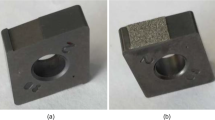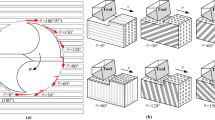Abstract
The machining of laminated composite components or armors consisting of engineering ceramics, fiber-reinforced plastic, and even aluminum or titanium alloy is a great challenge to manufacturing engineers. So far, quite limited literatures can be found concerning the machining of laminated composite components, and the quite limited studies are mainly focused on the stacks consisting of metal plates and composite materials. Also, there is hardly any report concerning the cutting techniques of laminated composite components or armors. In this work, the cutting techniques of three types of composite armors such as the Kevlar fiber-reinforced plastic (KFRP) protection inner lineplate, the ceramic composite armor (ceramics/glass fiber-reinforced plastics/aluminum alloy laminate), and the double-plate composite armor (ceramics/KFRP laminate) were studied experimentally on a desktop cutting machine, using a sintering diamond saw. Two types of machining processes such as cocurrent cutting and reverse cutting were discussed, and finally, reverse cutting is recommended for better cutting quality. Cutting tests indicated that under proper processing conditions, high-quality cutting of composite armors can be carried out by using a sintering diamond saw.
Similar content being viewed by others
References
Skaggs SR (2003) A brief history of ceramic armor development. Ceram Eng Sci Proc 24(3):337–349
Hou HL, Zhu X, Kan YL (2008) The advance of ballistic performance of light ceramic composite armor under the impact of projectile. Acta Armamentarii 29(2):208–216 (In chinese)
Bhattacharyya D, Horrigan DPW (1998) A study of hole drilling in Kevlar composites. Compos Sci Technol 58(2):267–283
Davim JP, Reis P, Antόnio CC (2004) Experimental study of drilling glass fiber reinforced plastics (GFRP) manufactured by hand-lay up. Compos Sci Technol 64:289–297
Davim JP, Rubio JC, Abrao AM (2007) A novel approach based on digital analysis to evaluate the delamination factor after drilling composite laminates. Compos Sci Technol 67:1939–1945
Rubio JC, Abrao AM, Faria PE, Correia AE, Davim JP (2008) Effects of high speed in the drilling of glass fibre reinforced plastic: evaluation of the delamination factor. Int J Mach Tools Manuf 48:715–720
Sardinas RQ, Reis P, Davim JP (2006) Multi-objective optimization of cutting parameters for drilling laminate composite materials by using genetic algorithms. Compos Sci Technol 66:3083–3088
Singh I, Bhatnagar N (2006) Drilling-induced damage in uni-directional glass fiber reinforced plastic (UD-GFRP) composite laminates. Int J Adv Manuf Technol 27:877–882
Singh I, Bhatnagar N (2006) Drilling of uni-directional glass fiber reinforced plastic (UD-GFRP) composite laminates. Int J Adv Manuf Technol 27:870–876
Arul S, Vijayaraghavan L, Malhotra SK, Krishnamurthy R (2006) Influence of tool material on dynamics of drilling of GFRP composites. Int J Adv Manuf Technol 29:655–662
Tsao CC (2008) Comparison between response surface methodology and radial basis function network for core-center drill in drilling composite materials. Int J Adv Manuf Technol 37:1061–1068
Ramulu M, Branson T, Kim D (2001) A study on the drilling of composite and titanium stacks. Compos Struct 54:67–77
Kim D, Ramulu M (2004) Drilling process optimization for graphite/bismaleimide–titanium alloy stacks. Compos Struct 63:101–114
Kim GW, Lee KY (2005) Critical thrust force at propagation of delamination zone due to drilling of FRP-metallic strips. Compos Struct 69:137–141
Zitoune R, Krishnaraj V, Collombet F (2010) Study of drilling of composite material and aluminium stack. Compos Struct 92:1246–1255
Zheng L, Zuo WM, Feng BF, Yuan JT (2010) A technical study of hole drilling in ceramics/FRP laminate composite components. Adv Mater Res 97–101:1965–1970
Zheng L, Wang BW, Feng BF, Gao C, Yuan JT (2011) Experimental study on trepanning drilling of the ceramic composite armor using a sintering diamond tool. Int J Adv Manuf Technol 56:421–427
Author information
Authors and Affiliations
Corresponding author
Rights and permissions
About this article
Cite this article
Lei, Z., Hai, Z., Chao, G. et al. An experimental study on machining techniques of cutting composite armors. Int J Adv Manuf Technol 64, 263–268 (2013). https://doi.org/10.1007/s00170-012-4025-3
Received:
Accepted:
Published:
Issue Date:
DOI: https://doi.org/10.1007/s00170-012-4025-3




